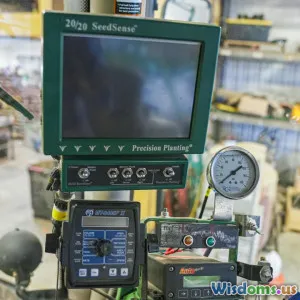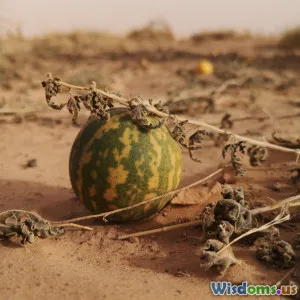
5 Surprising Ways Robots Are Transforming Agriculture Today
7 min read Discover 5 unexpected ways robots revolutionize agriculture, boosting efficiency, sustainability, and innovation in farming today. (0 Reviews)
5 Surprising Ways Robots Are Transforming Agriculture Today
Agriculture is on the cusp of a technological revolution. While many think robots in agriculture are limited to big tractors and automated plows, a new wave of robotic innovation is fundamentally reshaping how food is grown, monitored, and harvested. These developments not only boost efficiency but also promote sustainability and precision that were unimaginable only a decade ago. This article delves into five surprising examples where robots aren’t just tools but active agents reinventing agriculture’s future.
1. Autonomous Weed Control: Precision Without Chemicals
One of the major challenges in farming is invasive weed management. Traditional herbicide use, while effective, raises environmental and health concerns due to chemical runoff. Enter autonomous robotic weeders such as The Bonirob from BOSCH and Ecorobotix’s AVO explorer. These small, smart machines navigate fields, identifying and selectively spraying or uprooting weeds with incredible accuracy.
For example, the Ecorobotix AVO uses AI-driven cameras to distinguish crops from weeds. By spraying herbicides only on weed plants row-by-row, it reduces chemical use by up to 90%. The environmental benefits include lower soil contamination and less impact on nearby wildlife. Farmers also benefit financially by using fewer expensive chemicals. This robotic approach proves that precision agriculture can coexist with sustainability goals.
2. Robot Bees: Pollination Revolution
Pollinator populations worldwide are in alarming decline, threatening crop yields dependent on insect pollination. Robotic pollinators, like the RoboBee developed by Harvard University, offer a futuristic yet practical response.
These small drones mimic natural bee behavior, able to pollinate crops in greenhouses or open fields when natural bee populations falter due to pesticides or disease. Apart from securing food supply, robotic pollinators can operate under controlled parameters ensuring optimum pollination times and conditions that maximize crop output.
Though still emerging, trial farms in Japan and the Netherlands have begun testing robotic pollination systems, eagerly seeking solutions amid global pollinator scarcity.
3. Harvesting Robots: Faster, Smarter Crop Collection
Timely harvesting impacts crop quality and farm profitability. Robotic harvesters such as Agrobot’s E-series strawberry picker or FFRobotics’ apple harvester combine advanced vision systems with dexterous manipulation to identify ripe produce and harvest gently but efficiently.
The Agrobot E-series utilizes hyperspectral imaging to detect the perfect strawberry ripeness, reducing waste from unripe or damaged fruits. Its multitasking capabilities allow 24/7 operation alongside human teams, increasing picking capacity without labor fatigue.
Similarly, Japan’s new apple-picking robots reduce dependency on seasonal migrant labor, easing human shortages while ensuring apples are picked at peak flavor.
4. Multi-Spectral Drones: Eyes in the Sky for Crop Health
Modern drones equipped with multi-spectral and thermal cameras revolutionize crop monitoring. These robots fly over vast fields rapidly, surveying plant health, detecting disease, soil moisture, nutrient deficiencies, and even pest infestations with remarkable precision.
Companies like DroneDeploy and Parrot offer platforms integrating AI that analyze drone data in real time. For instance, a thermal reading might indicate water stress long before visible signs emerge, allowing farmers to adjust irrigation accurately — conserving water and boosting yields.
A 2022 study in California vineyards found drone monitoring practices improved grape quality and volume by 15%, demonstrating clear ROI.
5. Soil-sensing Robots: Underground Data for Better Decisions
Understanding soil conditions is critical to tailored fertilizer and irrigation strategies, yet traditional sampling is time-consuming and offers limited spatial resolution. Soil-sensing robots such as Tertill or autonomous rovers like EarthSense’s Rowbot crawl between crops taking continuous readings on moisture levels, nutrient content, and pH in real time.
This immediate granular data empowers precision application of inputs — preventing over-fertilization that damages ecosystems while optimizing production. Some robots even incorporate AI learning models to predict crop stress and recommend interventions proactively.
By turning opaque underground ecosystems transparent, soil robots represent a leap forward in smart farming.
Conclusion
The integration of robotic technology in agriculture goes well beyond simple automation—it heralds a fundamental transformation of the food production landscape. Autonomous weeders reduce chemical dependency dramatically. Robot bees tackle the critical pollination crisis. Harvesting robots enable faster, gentler crop collection, easing labor shortages. Drone surveillance provides actionable insights at an unprecedented scale, and soil-sensing robots deliver deep underground intelligence.
Farmers embracing these innovations can increase yields, protect the environment, and build resilience against climate variability and resource scarcity. As these robot-powered tools become more affordable and accessible, they promise—not speculation but tangible, real-world benefits—that will shape the future of farming globally.
Whether you’re a farmer, ag-tech developer, or simply a curious global citizen, the story unfolding in fields worldwide is one of hope, sustainability, and human ingenuity supported by intelligent robots.
The agriculture of tomorrow is robotic—precise, efficient, and inspired.
Rate the Post
User Reviews
Popular Posts
















